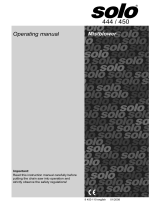
2 unigreen
Summary
1 USING AND KEEPING THE USE AND MAINTENANCE MANUAL .................... 4
1.1 COMPOSITION OF THE MANUAL ....................................................................................... 4
1.2 GUARANTEE ....................................................................................................................... 4
1.3 PRODUCT RESPONSIBILITY .............................................................................................. 4
1.4 WARNING SIGNS IN THE MANUAL AND ON THE MACHINE ............................................. 4
2 SAFETY REGULATIONS AND RESIDUAL RISKS .............................................. 5
2.1 INTENDED USE ................................................................................................................... 6
2.2 PROHIBITED USE ...............................................................................................................6
2.3 USING CHEMICAL PRODUCTS .......................................................................................... 6
2.3.1 REGULATIONS FOR THE USE OF CHEMICAL PRODUCTS ............................................... 6
2.4 RECOMMENDATIONS ......................................................................................................... 6
2.4.1 TAKING PRECAUTIONS AGAINST FIRE HAZARDS ........................................................... 7
2.5 WEATHER CONDITIONS ..................................................................................................... 7
2.6 MACHINES DESIGNED TO BE USED ONLY WITH CLEAN WATER .................................... 7
2.7 DRIVING ON THE ROAD ..................................................................................................... 7
3 CHARACTERISTICS AND SPECIFICATIONS ..................................................... 7
3.1 TABLES OF FITTINGS ALLOWED ....................................................................................... 7
3.2 NOISE LEVEL OF THE MACHINE ....................................................................................... 8
3.3 STANDARDS OF REFERENCE: ........................................................................................... 8
4 USER’S INSTRUCTIONS ....................................................................................... 8
4.1 DESCRIPTION OF THE MACHINE ...................................................................................... 8
4.1.1 HAND WASHING TANKS ...................................................................................................... 8
4.2 PRELIMINARY CHECKS ...................................................................................................... 9
4.3 TRANSPORTING AND MOVING THE MACHINE ................................................................. 9
4.3.1 TOWED ATOMISERS ........................................................................................................... 9
4.4 TRACTOR COUPLING ........................................................................................................ 10
4.4.1 DRAWBAR WITH TOWING EYE OR FORK .........................................................................10
4.4.2 STEERING DRAWBAR (COUPLED TO ELEVATOR) ...........................................................10
4.4.3 STEERING DRAWBAR (TOWING EYE) ..............................................................................10
4.4.4 ADJUSTABLE HUBS ...........................................................................................................10
4.4.5 HYDRAULIC CONNECTION TO THE DISTRIBUTORS ........................................................10
4.5 CARDAN SHAFT .................................................................................................................11
4.6 PUMP ..................................................................................................................................11
4.7 SUCTION FILTER ...............................................................................................................11
4.8 PRESSURE REGULATOR ...................................................................................................12
4.8.1 COMPONENTS OF THE PRESSURE REGULATOR ...........................................................12
4.8.2 GENERAL INSTRUCTIONS ................................................................................................12
4.9.1 DELIVERY FILTERS (ONLY EQUIPPED MODELS) ............................................................13
4.10 FILLING THE TANK ............................................................................................................. 14
4.11 TEST WITH CLEAN WATER ................................................................................................ 14
4.12 MIXING ............................................................................................................................... 15
4.12.1 MANUAL PREMIXING .........................................................................................................15
4.12.2 PREMIXER ON COVER (OPTIONAL): ................................................................................ 15
4.12.3 PREMIXER ON HOPPER WITH TIN WASHER ...................................................................15
4.13 WASHING THE ATOMISER .................................................................................................16
4.13.1 CIRCUIT WASHER AND TANK WASHER ............................................................................16
5 BLOWER GROUP ................................................................................................ 17
5.1 AXIAL BLOWER GROUP WITH PULLEY ............................................................................ 17
5.2 AXIAL BLOWER GROUP WITH MULTIPLIER ..................................................................... 17
5.3 BLOWER GROUP WITH FRONT SUCTION ........................................................................17
5.4 AXIAL ROTOR .....................................................................................................................18
5.5 CLUTCH ..............................................................................................................................18
5.6 CANNON BLOWER GROUP ...............................................................................................18
5.6.1 MANUALLY INCLINABILE HEAD .........................................................................................18
5.6.2 HYDRAULIC DRIVEN HEADS .............................................................................................18
5.6.3 HYDRAULIC DRIVES ..........................................................................................................18
5.6.4 OIL FEED FROM TRACTOR ............................................................................................... 19
6 SPRAYING ............................................................................................................ 19
6.1 DESCRIPTION OF TYPE OF JETS .................................................................................... 19
6.2 DESCRIPTION OF TYPE OF NOZZLES ............................................................................. 19
6.2.1 NORMAL VOLUME CONICAL NOZZLES (OVER 500L/HA) ................................................. 19
6.2.2 LOW VOLUME CONICAL NOZZLES (150-500L/HA) ............................................................20



























